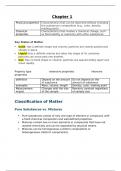Other
PHYS204 Physics Lab 5 - Linear Momentum, Kinetic and Potential Energy
- Course
- Institution
This lab studies the forces and motion involved in a bouncing object in free fall under the influence of gravity, with sharp upward forces at each contact with the ground. Newton’s third law is extensively discussed, along with kinetic and potential energy and linear momentum.
[Show more]





